CHCCCS001: Addressing the Needs of People with Chronic Disease
VerifiedAdded on 2023/06/18
|17
|3547
|260
Homework Assignment
AI Summary
This assignment provides detailed answers to fifteen questions related to addressing the needs of individuals with chronic diseases, as part of the CHCCCS001 unit. It covers various aspects including the characteristics of chronic illnesses according to the World Health Organization, examples of major chronic conditions in Australia (such as asthma, diabetes, heart disease, cancer, and kidney disease), and the Wagner Model for chronic illness. The assignment also explains Integrated Chronic Disease Management (ICDM), the impact of life conditions on health and well-being, the core elements of chronic disease prevention and care, and the Australian National Chronic Disease Strategy. Further topics include the importance of maintaining a positive life role for individuals with chronic illnesses and the five stages of the transtheoretical model of change.
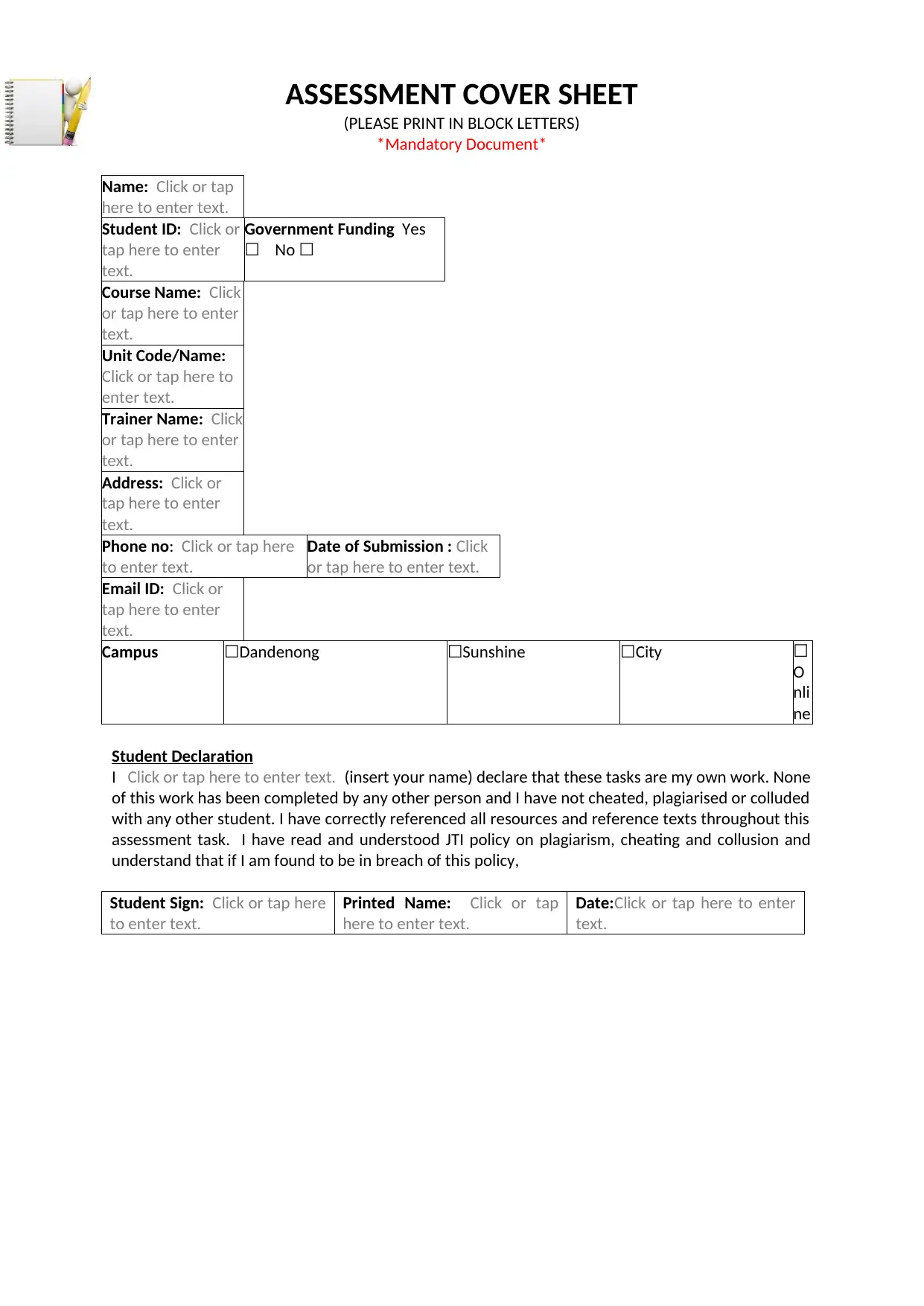
ASSESSMENT COVER SHEET
(PLEASE PRINT IN BLOCK LETTERS)
*Mandatory Document*
Name: Click or tap
here to enter text.
Student ID: Click or
tap here to enter
text.
Government Funding Yes
☐ No ☐
Course Name: Click
or tap here to enter
text.
Unit Code/Name:
Click or tap here to
enter text.
Trainer Name: Click
or tap here to enter
text.
Address: Click or
tap here to enter
text.
Phone no: Click or tap here
to enter text.
Date of Submission : Click
or tap here to enter text.
Email ID: Click or
tap here to enter
text.
Campus ☐Dandenong ☐Sunshine ☐City ☐
O
nli
ne
Student Declaration
I Click or tap here to enter text. (insert your name) declare that these tasks are my own work. None
of this work has been completed by any other person and I have not cheated, plagiarised or colluded
with any other student. I have correctly referenced all resources and reference texts throughout this
assessment task. I have read and understood JTI policy on plagiarism, cheating and collusion and
understand that if I am found to be in breach of this policy,
Student Sign: Click or tap here
to enter text.
Printed Name: Click or tap
here to enter text.
Date:Click or tap here to enter
text.
(PLEASE PRINT IN BLOCK LETTERS)
*Mandatory Document*
Name: Click or tap
here to enter text.
Student ID: Click or
tap here to enter
text.
Government Funding Yes
☐ No ☐
Course Name: Click
or tap here to enter
text.
Unit Code/Name:
Click or tap here to
enter text.
Trainer Name: Click
or tap here to enter
text.
Address: Click or
tap here to enter
text.
Phone no: Click or tap here
to enter text.
Date of Submission : Click
or tap here to enter text.
Email ID: Click or
tap here to enter
text.
Campus ☐Dandenong ☐Sunshine ☐City ☐
O
nli
ne
Student Declaration
I Click or tap here to enter text. (insert your name) declare that these tasks are my own work. None
of this work has been completed by any other person and I have not cheated, plagiarised or colluded
with any other student. I have correctly referenced all resources and reference texts throughout this
assessment task. I have read and understood JTI policy on plagiarism, cheating and collusion and
understand that if I am found to be in breach of this policy,
Student Sign: Click or tap here
to enter text.
Printed Name: Click or tap
here to enter text.
Date:Click or tap here to enter
text.
Paraphrase This Document
Need a fresh take? Get an instant paraphrase of this document with our AI Paraphraser

Page left intentionally blank
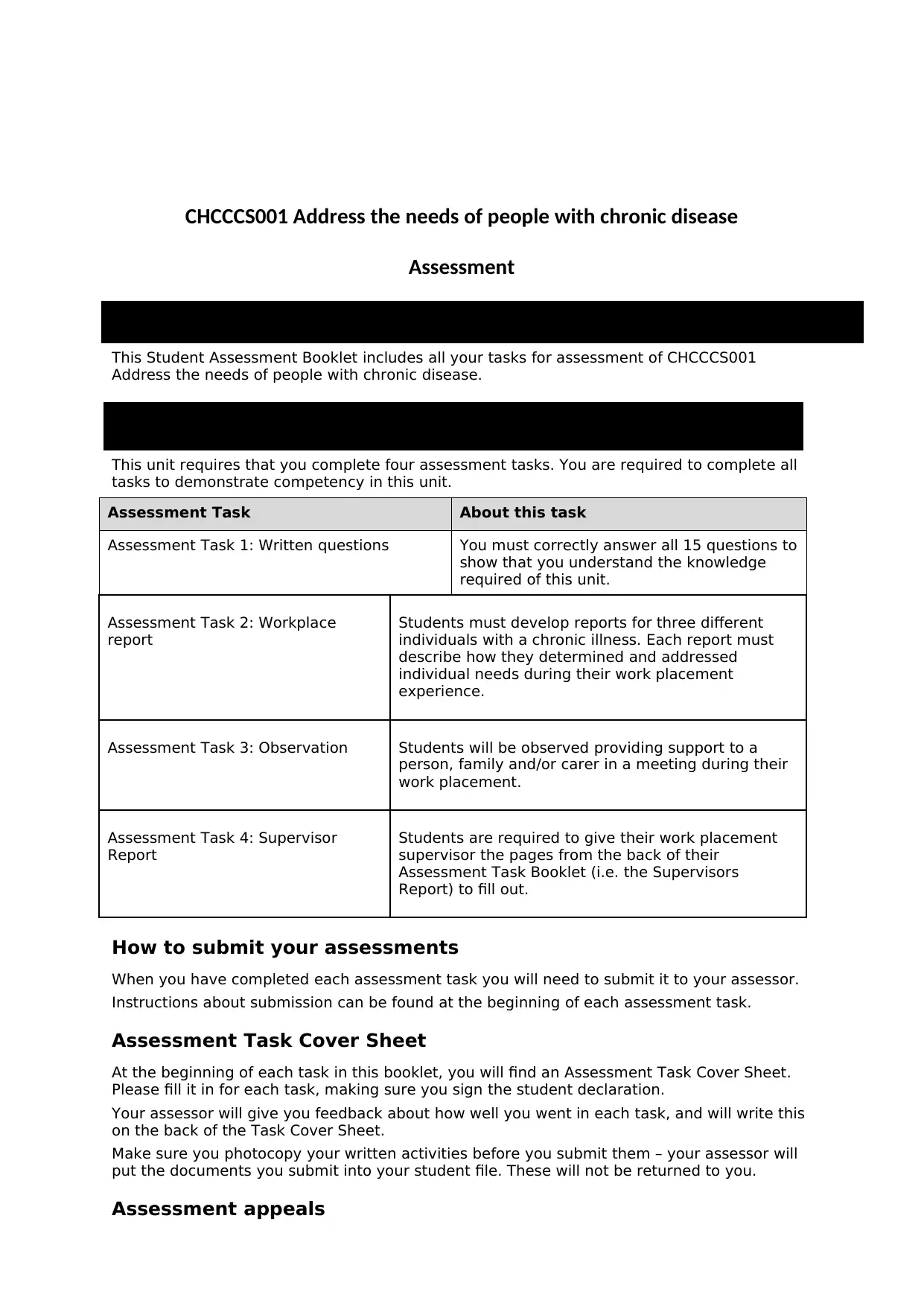
CHCCCS001 Address the needs of people with chronic disease
Assessment
ASSESSMENT OVERVIEW
This Student Assessment Booklet includes all your tasks for assessment of CHCCCS001
Address the needs of people with chronic disease.
ABOUT YOUR ASSESSMENTS
This unit requires that you complete four assessment tasks. You are required to complete all
tasks to demonstrate competency in this unit.
Assessment Task About this task
Assessment Task 1: Written questions You must correctly answer all 15 questions to
show that you understand the knowledge
required of this unit.
Assessment Task 2: Workplace
report
Students must develop reports for three different
individuals with a chronic illness. Each report must
describe how they determined and addressed
individual needs during their work placement
experience.
Assessment Task 3: Observation Students will be observed providing support to a
person, family and/or carer in a meeting during their
work placement.
Assessment Task 4: Supervisor
Report
Students are required to give their work placement
supervisor the pages from the back of their
Assessment Task Booklet (i.e. the Supervisors
Report) to fill out.
How to submit your assessments
When you have completed each assessment task you will need to submit it to your assessor.
Instructions about submission can be found at the beginning of each assessment task.
Assessment Task Cover Sheet
At the beginning of each task in this booklet, you will find an Assessment Task Cover Sheet.
Please fill it in for each task, making sure you sign the student declaration.
Your assessor will give you feedback about how well you went in each task, and will write this
on the back of the Task Cover Sheet.
Make sure you photocopy your written activities before you submit them – your assessor will
put the documents you submit into your student file. These will not be returned to you.
Assessment appeals
Assessment
ASSESSMENT OVERVIEW
This Student Assessment Booklet includes all your tasks for assessment of CHCCCS001
Address the needs of people with chronic disease.
ABOUT YOUR ASSESSMENTS
This unit requires that you complete four assessment tasks. You are required to complete all
tasks to demonstrate competency in this unit.
Assessment Task About this task
Assessment Task 1: Written questions You must correctly answer all 15 questions to
show that you understand the knowledge
required of this unit.
Assessment Task 2: Workplace
report
Students must develop reports for three different
individuals with a chronic illness. Each report must
describe how they determined and addressed
individual needs during their work placement
experience.
Assessment Task 3: Observation Students will be observed providing support to a
person, family and/or carer in a meeting during their
work placement.
Assessment Task 4: Supervisor
Report
Students are required to give their work placement
supervisor the pages from the back of their
Assessment Task Booklet (i.e. the Supervisors
Report) to fill out.
How to submit your assessments
When you have completed each assessment task you will need to submit it to your assessor.
Instructions about submission can be found at the beginning of each assessment task.
Assessment Task Cover Sheet
At the beginning of each task in this booklet, you will find an Assessment Task Cover Sheet.
Please fill it in for each task, making sure you sign the student declaration.
Your assessor will give you feedback about how well you went in each task, and will write this
on the back of the Task Cover Sheet.
Make sure you photocopy your written activities before you submit them – your assessor will
put the documents you submit into your student file. These will not be returned to you.
Assessment appeals
⊘ This is a preview!⊘
Do you want full access?
Subscribe today to unlock all pages.

Trusted by 1+ million students worldwide

You can make an appeal about an assessment decision by putting it in writing and sending it
to us. Refer to your Student Handbook for more information about our appeals process.
to us. Refer to your Student Handbook for more information about our appeals process.
Paraphrase This Document
Need a fresh take? Get an instant paraphrase of this document with our AI Paraphraser
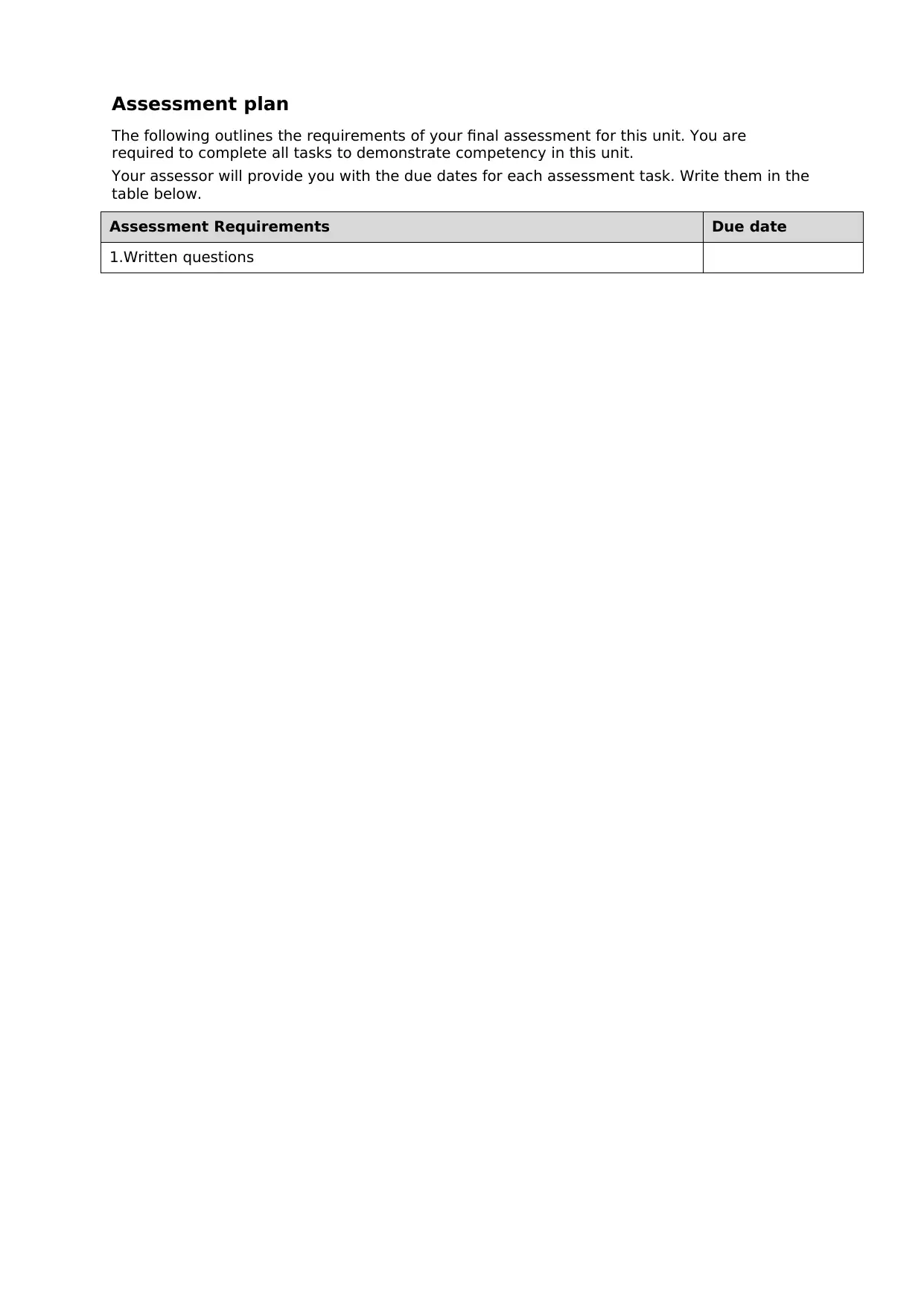
Assessment plan
The following outlines the requirements of your final assessment for this unit. You are
required to complete all tasks to demonstrate competency in this unit.
Your assessor will provide you with the due dates for each assessment task. Write them in the
table below.
Assessment Requirements Due date
1.Written questions
The following outlines the requirements of your final assessment for this unit. You are
required to complete all tasks to demonstrate competency in this unit.
Your assessor will provide you with the due dates for each assessment task. Write them in the
table below.
Assessment Requirements Due date
1.Written questions
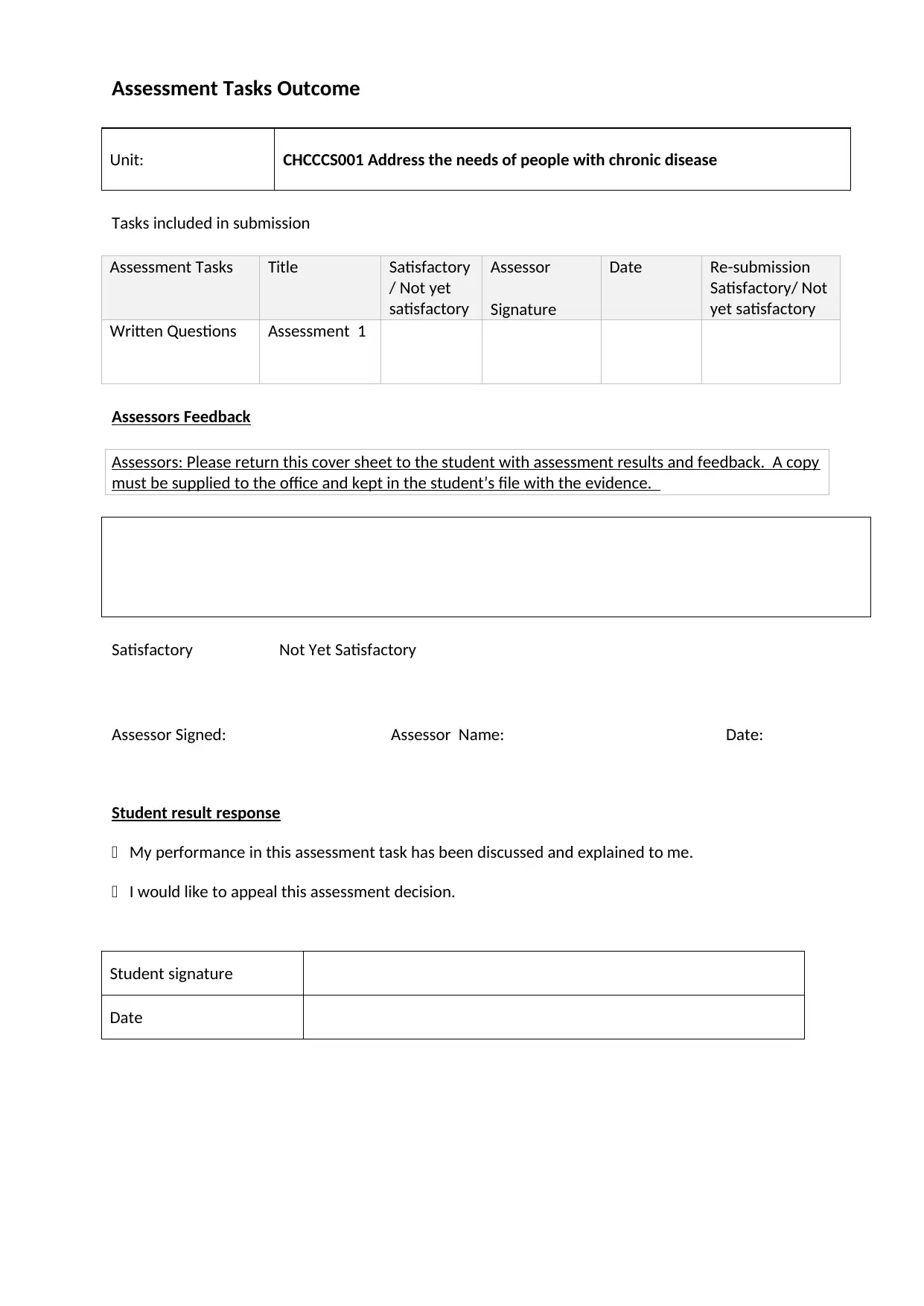
Assessment Tasks Outcome
Unit: CHCCCS001 Address the needs of people with chronic disease
Tasks included in submission
Assessment Tasks Title Satisfactory
/ Not yet
satisfactory
Assessor
Signature
Date Re-submission
Satisfactory/ Not
yet satisfactory
Written Questions Assessment 1
Assessors Feedback
Assessors: Please return this cover sheet to the student with assessment results and feedback. A copy
must be supplied to the office and kept in the student’s file with the evidence.
Satisfactory Not Yet Satisfactory
Assessor Signed: Assessor Name: Date:
Student result response
◻ My performance in this assessment task has been discussed and explained to me.
◻ I would like to appeal this assessment decision.
Student signature
Date
Unit: CHCCCS001 Address the needs of people with chronic disease
Tasks included in submission
Assessment Tasks Title Satisfactory
/ Not yet
satisfactory
Assessor
Signature
Date Re-submission
Satisfactory/ Not
yet satisfactory
Written Questions Assessment 1
Assessors Feedback
Assessors: Please return this cover sheet to the student with assessment results and feedback. A copy
must be supplied to the office and kept in the student’s file with the evidence.
Satisfactory Not Yet Satisfactory
Assessor Signed: Assessor Name: Date:
Student result response
◻ My performance in this assessment task has been discussed and explained to me.
◻ I would like to appeal this assessment decision.
Student signature
Date
⊘ This is a preview!⊘
Do you want full access?
Subscribe today to unlock all pages.

Trusted by 1+ million students worldwide
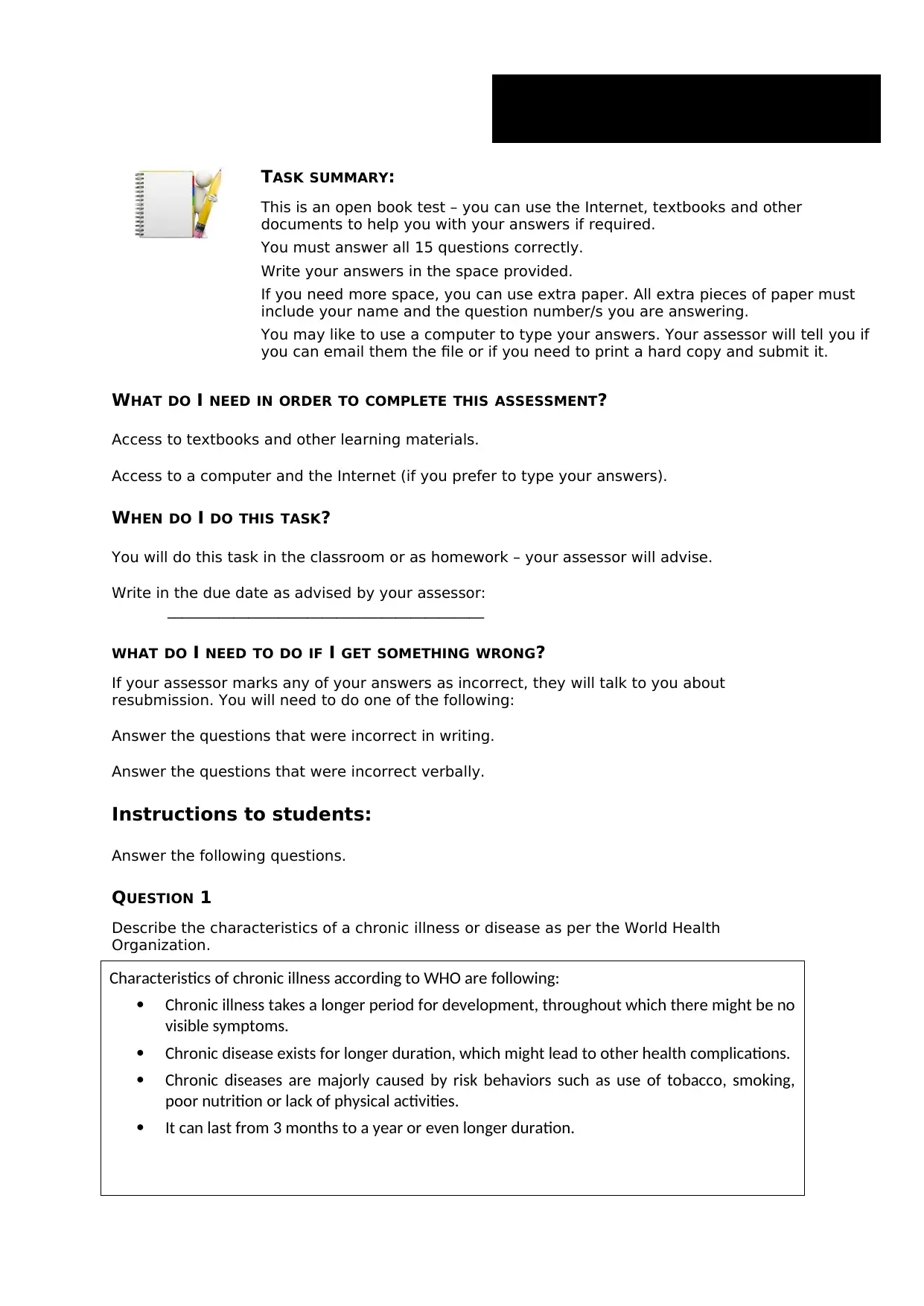
ASSESSMENT TASK 1: WRITTEN
QUESTIONS
TASK SUMMARY:
This is an open book test – you can use the Internet, textbooks and other
documents to help you with your answers if required.
You must answer all 15 questions correctly.
Write your answers in the space provided.
If you need more space, you can use extra paper. All extra pieces of paper must
include your name and the question number/s you are answering.
You may like to use a computer to type your answers. Your assessor will tell you if
you can email them the file or if you need to print a hard copy and submit it.
WHAT DO I NEED IN ORDER TO COMPLETE THIS ASSESSMENT?
Access to textbooks and other learning materials.
Access to a computer and the Internet (if you prefer to type your answers).
WHEN DO I DO THIS TASK?
You will do this task in the classroom or as homework – your assessor will advise.
Write in the due date as advised by your assessor:
___________________________________________
WHAT DO I NEED TO DO IF I GET SOMETHING WRONG?
If your assessor marks any of your answers as incorrect, they will talk to you about
resubmission. You will need to do one of the following:
Answer the questions that were incorrect in writing.
Answer the questions that were incorrect verbally.
Instructions to students:
Answer the following questions.
QUESTION 1
Describe the characteristics of a chronic illness or disease as per the World Health
Organization.
Characteristics of chronic illness according to WHO are following:
Chronic illness takes a longer period for development, throughout which there might be no
visible symptoms.
Chronic disease exists for longer duration, which might lead to other health complications.
Chronic diseases are majorly caused by risk behaviors such as use of tobacco, smoking,
poor nutrition or lack of physical activities.
It can last from 3 months to a year or even longer duration.
QUESTIONS
TASK SUMMARY:
This is an open book test – you can use the Internet, textbooks and other
documents to help you with your answers if required.
You must answer all 15 questions correctly.
Write your answers in the space provided.
If you need more space, you can use extra paper. All extra pieces of paper must
include your name and the question number/s you are answering.
You may like to use a computer to type your answers. Your assessor will tell you if
you can email them the file or if you need to print a hard copy and submit it.
WHAT DO I NEED IN ORDER TO COMPLETE THIS ASSESSMENT?
Access to textbooks and other learning materials.
Access to a computer and the Internet (if you prefer to type your answers).
WHEN DO I DO THIS TASK?
You will do this task in the classroom or as homework – your assessor will advise.
Write in the due date as advised by your assessor:
___________________________________________
WHAT DO I NEED TO DO IF I GET SOMETHING WRONG?
If your assessor marks any of your answers as incorrect, they will talk to you about
resubmission. You will need to do one of the following:
Answer the questions that were incorrect in writing.
Answer the questions that were incorrect verbally.
Instructions to students:
Answer the following questions.
QUESTION 1
Describe the characteristics of a chronic illness or disease as per the World Health
Organization.
Characteristics of chronic illness according to WHO are following:
Chronic illness takes a longer period for development, throughout which there might be no
visible symptoms.
Chronic disease exists for longer duration, which might lead to other health complications.
Chronic diseases are majorly caused by risk behaviors such as use of tobacco, smoking,
poor nutrition or lack of physical activities.
It can last from 3 months to a year or even longer duration.
Paraphrase This Document
Need a fresh take? Get an instant paraphrase of this document with our AI Paraphraser
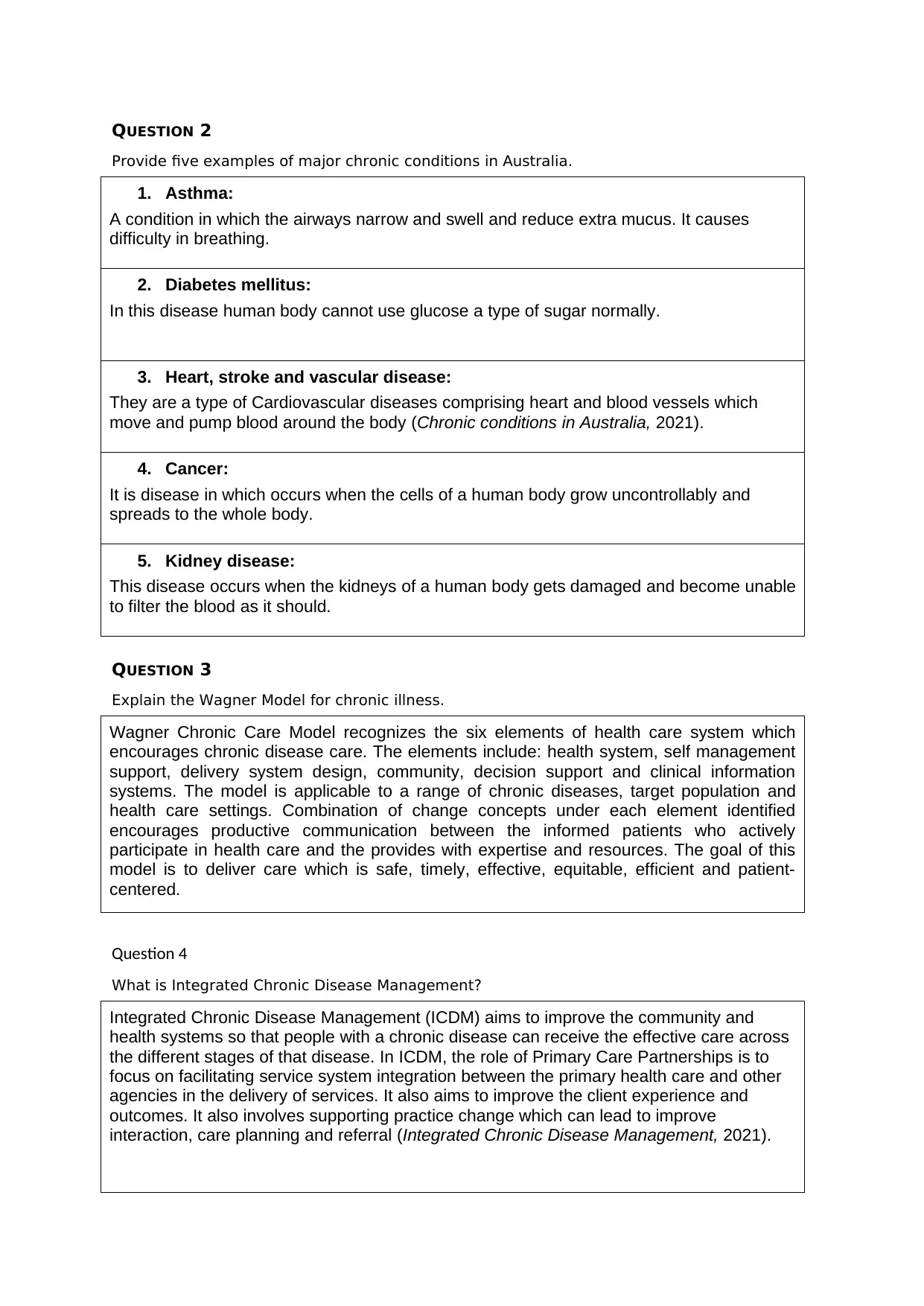
QUESTION 2
Provide five examples of major chronic conditions in Australia.
1. Asthma:
A condition in which the airways narrow and swell and reduce extra mucus. It causes
difficulty in breathing.
2. Diabetes mellitus:
In this disease human body cannot use glucose a type of sugar normally.
3. Heart, stroke and vascular disease:
They are a type of Cardiovascular diseases comprising heart and blood vessels which
move and pump blood around the body (Chronic conditions in Australia, 2021).
4. Cancer:
It is disease in which occurs when the cells of a human body grow uncontrollably and
spreads to the whole body.
5. Kidney disease:
This disease occurs when the kidneys of a human body gets damaged and become unable
to filter the blood as it should.
QUESTION 3
Explain the Wagner Model for chronic illness.
Wagner Chronic Care Model recognizes the six elements of health care system which
encourages chronic disease care. The elements include: health system, self management
support, delivery system design, community, decision support and clinical information
systems. The model is applicable to a range of chronic diseases, target population and
health care settings. Combination of change concepts under each element identified
encourages productive communication between the informed patients who actively
participate in health care and the provides with expertise and resources. The goal of this
model is to deliver care which is safe, timely, effective, equitable, efficient and patient-
centered.
Question 4
What is Integrated Chronic Disease Management?
Integrated Chronic Disease Management (ICDM) aims to improve the community and
health systems so that people with a chronic disease can receive the effective care across
the different stages of that disease. In ICDM, the role of Primary Care Partnerships is to
focus on facilitating service system integration between the primary health care and other
agencies in the delivery of services. It also aims to improve the client experience and
outcomes. It also involves supporting practice change which can lead to improve
interaction, care planning and referral (Integrated Chronic Disease Management, 2021).
Provide five examples of major chronic conditions in Australia.
1. Asthma:
A condition in which the airways narrow and swell and reduce extra mucus. It causes
difficulty in breathing.
2. Diabetes mellitus:
In this disease human body cannot use glucose a type of sugar normally.
3. Heart, stroke and vascular disease:
They are a type of Cardiovascular diseases comprising heart and blood vessels which
move and pump blood around the body (Chronic conditions in Australia, 2021).
4. Cancer:
It is disease in which occurs when the cells of a human body grow uncontrollably and
spreads to the whole body.
5. Kidney disease:
This disease occurs when the kidneys of a human body gets damaged and become unable
to filter the blood as it should.
QUESTION 3
Explain the Wagner Model for chronic illness.
Wagner Chronic Care Model recognizes the six elements of health care system which
encourages chronic disease care. The elements include: health system, self management
support, delivery system design, community, decision support and clinical information
systems. The model is applicable to a range of chronic diseases, target population and
health care settings. Combination of change concepts under each element identified
encourages productive communication between the informed patients who actively
participate in health care and the provides with expertise and resources. The goal of this
model is to deliver care which is safe, timely, effective, equitable, efficient and patient-
centered.
Question 4
What is Integrated Chronic Disease Management?
Integrated Chronic Disease Management (ICDM) aims to improve the community and
health systems so that people with a chronic disease can receive the effective care across
the different stages of that disease. In ICDM, the role of Primary Care Partnerships is to
focus on facilitating service system integration between the primary health care and other
agencies in the delivery of services. It also aims to improve the client experience and
outcomes. It also involves supporting practice change which can lead to improve
interaction, care planning and referral (Integrated Chronic Disease Management, 2021).
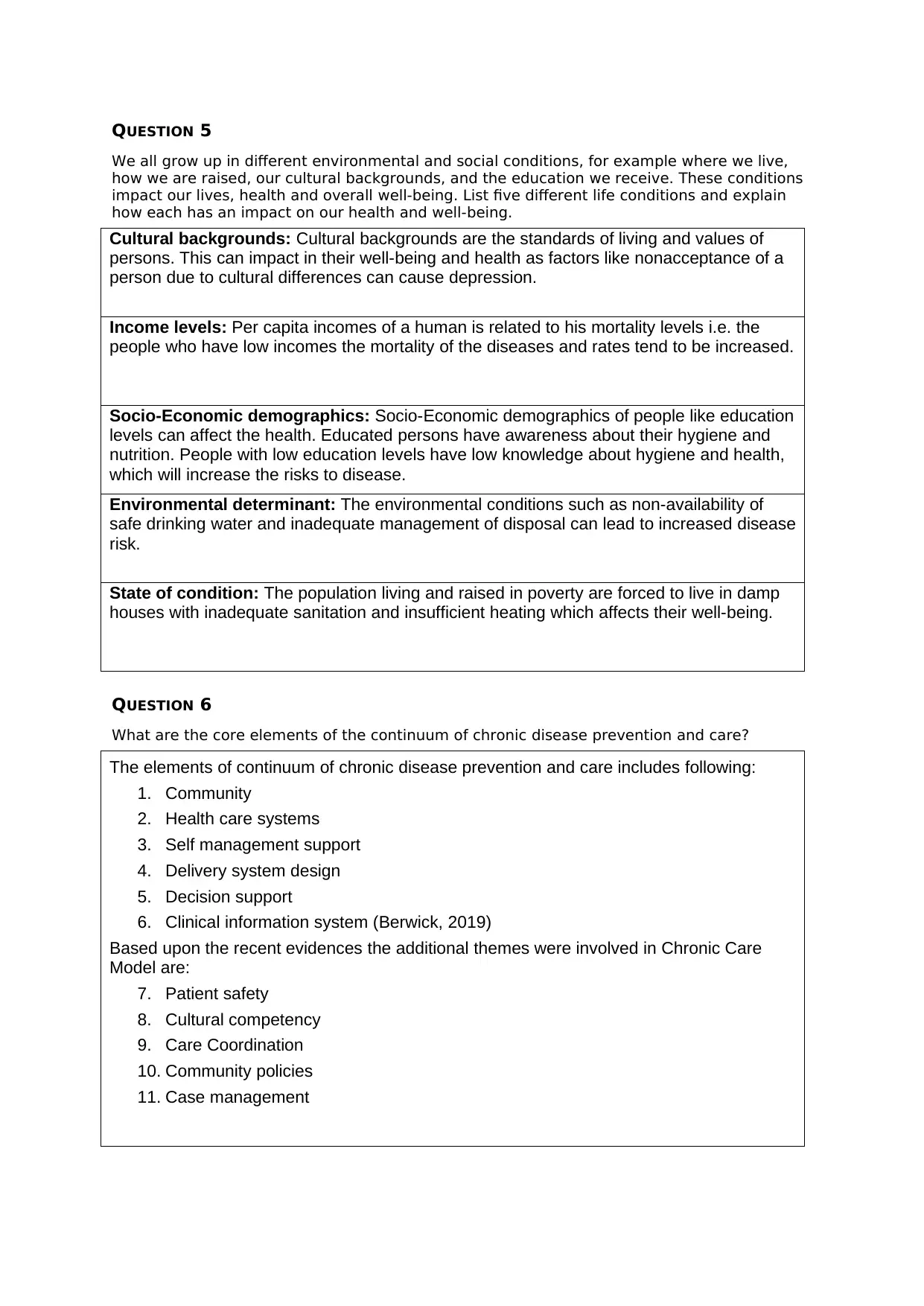
QUESTION 5
We all grow up in different environmental and social conditions, for example where we live,
how we are raised, our cultural backgrounds, and the education we receive. These conditions
impact our lives, health and overall well-being. List five different life conditions and explain
how each has an impact on our health and well-being.
Cultural backgrounds: Cultural backgrounds are the standards of living and values of
persons. This can impact in their well-being and health as factors like nonacceptance of a
person due to cultural differences can cause depression.
Income levels: Per capita incomes of a human is related to his mortality levels i.e. the
people who have low incomes the mortality of the diseases and rates tend to be increased.
Socio-Economic demographics: Socio-Economic demographics of people like education
levels can affect the health. Educated persons have awareness about their hygiene and
nutrition. People with low education levels have low knowledge about hygiene and health,
which will increase the risks to disease.
Environmental determinant: The environmental conditions such as non-availability of
safe drinking water and inadequate management of disposal can lead to increased disease
risk.
State of condition: The population living and raised in poverty are forced to live in damp
houses with inadequate sanitation and insufficient heating which affects their well-being.
QUESTION 6
What are the core elements of the continuum of chronic disease prevention and care?
The elements of continuum of chronic disease prevention and care includes following:
1. Community
2. Health care systems
3. Self management support
4. Delivery system design
5. Decision support
6. Clinical information system (Berwick, 2019)
Based upon the recent evidences the additional themes were involved in Chronic Care
Model are:
7. Patient safety
8. Cultural competency
9. Care Coordination
10. Community policies
11. Case management
We all grow up in different environmental and social conditions, for example where we live,
how we are raised, our cultural backgrounds, and the education we receive. These conditions
impact our lives, health and overall well-being. List five different life conditions and explain
how each has an impact on our health and well-being.
Cultural backgrounds: Cultural backgrounds are the standards of living and values of
persons. This can impact in their well-being and health as factors like nonacceptance of a
person due to cultural differences can cause depression.
Income levels: Per capita incomes of a human is related to his mortality levels i.e. the
people who have low incomes the mortality of the diseases and rates tend to be increased.
Socio-Economic demographics: Socio-Economic demographics of people like education
levels can affect the health. Educated persons have awareness about their hygiene and
nutrition. People with low education levels have low knowledge about hygiene and health,
which will increase the risks to disease.
Environmental determinant: The environmental conditions such as non-availability of
safe drinking water and inadequate management of disposal can lead to increased disease
risk.
State of condition: The population living and raised in poverty are forced to live in damp
houses with inadequate sanitation and insufficient heating which affects their well-being.
QUESTION 6
What are the core elements of the continuum of chronic disease prevention and care?
The elements of continuum of chronic disease prevention and care includes following:
1. Community
2. Health care systems
3. Self management support
4. Delivery system design
5. Decision support
6. Clinical information system (Berwick, 2019)
Based upon the recent evidences the additional themes were involved in Chronic Care
Model are:
7. Patient safety
8. Cultural competency
9. Care Coordination
10. Community policies
11. Case management
⊘ This is a preview!⊘
Do you want full access?
Subscribe today to unlock all pages.

Trusted by 1+ million students worldwide
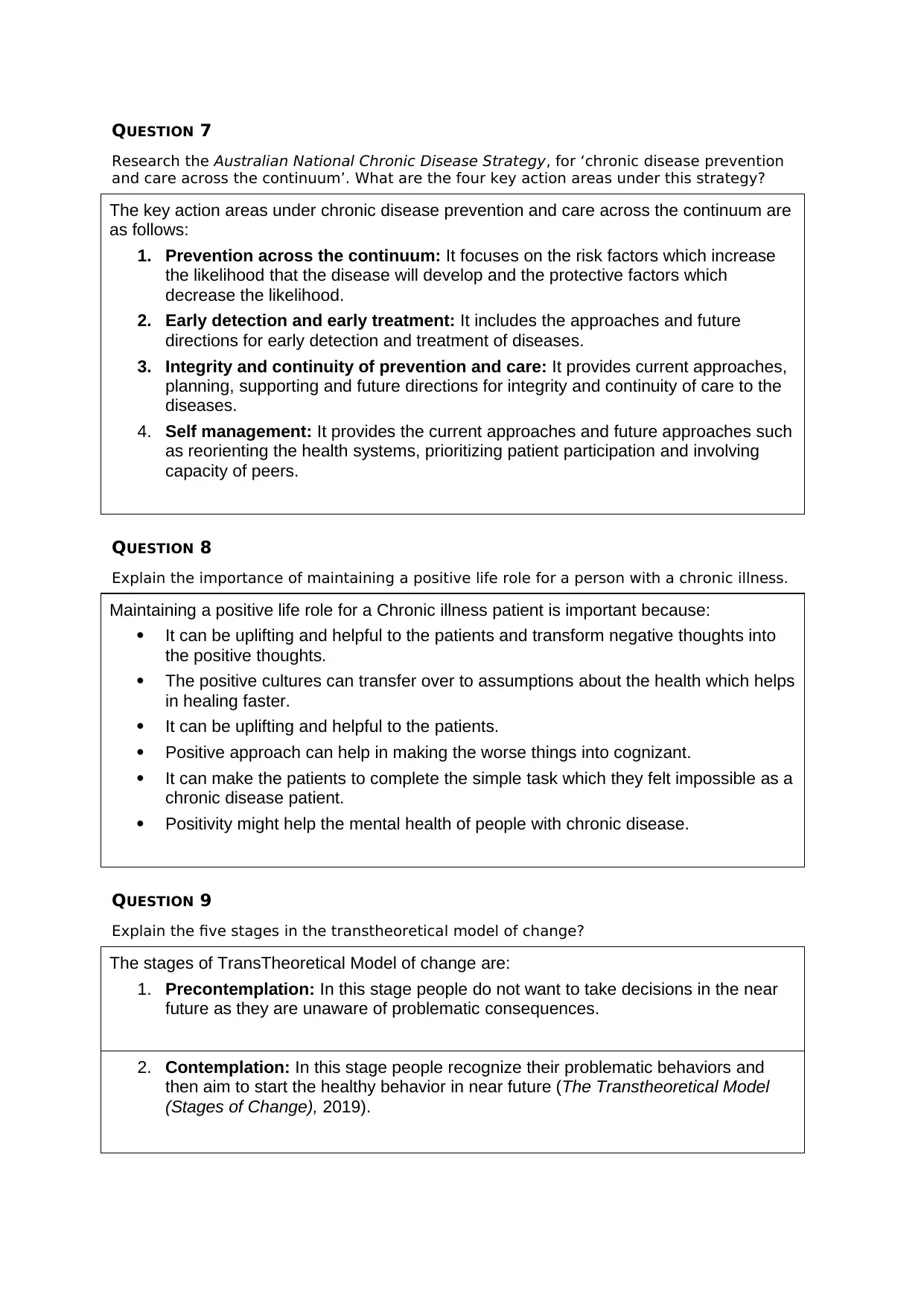
QUESTION 7
Research the Australian National Chronic Disease Strategy, for ‘chronic disease prevention
and care across the continuum’. What are the four key action areas under this strategy?
The key action areas under chronic disease prevention and care across the continuum are
as follows:
1. Prevention across the continuum: It focuses on the risk factors which increase
the likelihood that the disease will develop and the protective factors which
decrease the likelihood.
2. Early detection and early treatment: It includes the approaches and future
directions for early detection and treatment of diseases.
3. Integrity and continuity of prevention and care: It provides current approaches,
planning, supporting and future directions for integrity and continuity of care to the
diseases.
4. Self management: It provides the current approaches and future approaches such
as reorienting the health systems, prioritizing patient participation and involving
capacity of peers.
QUESTION 8
Explain the importance of maintaining a positive life role for a person with a chronic illness.
Maintaining a positive life role for a Chronic illness patient is important because:
It can be uplifting and helpful to the patients and transform negative thoughts into
the positive thoughts.
The positive cultures can transfer over to assumptions about the health which helps
in healing faster.
It can be uplifting and helpful to the patients.
Positive approach can help in making the worse things into cognizant.
It can make the patients to complete the simple task which they felt impossible as a
chronic disease patient.
Positivity might help the mental health of people with chronic disease.
QUESTION 9
Explain the five stages in the transtheoretical model of change?
The stages of TransTheoretical Model of change are:
1. Precontemplation: In this stage people do not want to take decisions in the near
future as they are unaware of problematic consequences.
2. Contemplation: In this stage people recognize their problematic behaviors and
then aim to start the healthy behavior in near future (The Transtheoretical Model
(Stages of Change), 2019).
Research the Australian National Chronic Disease Strategy, for ‘chronic disease prevention
and care across the continuum’. What are the four key action areas under this strategy?
The key action areas under chronic disease prevention and care across the continuum are
as follows:
1. Prevention across the continuum: It focuses on the risk factors which increase
the likelihood that the disease will develop and the protective factors which
decrease the likelihood.
2. Early detection and early treatment: It includes the approaches and future
directions for early detection and treatment of diseases.
3. Integrity and continuity of prevention and care: It provides current approaches,
planning, supporting and future directions for integrity and continuity of care to the
diseases.
4. Self management: It provides the current approaches and future approaches such
as reorienting the health systems, prioritizing patient participation and involving
capacity of peers.
QUESTION 8
Explain the importance of maintaining a positive life role for a person with a chronic illness.
Maintaining a positive life role for a Chronic illness patient is important because:
It can be uplifting and helpful to the patients and transform negative thoughts into
the positive thoughts.
The positive cultures can transfer over to assumptions about the health which helps
in healing faster.
It can be uplifting and helpful to the patients.
Positive approach can help in making the worse things into cognizant.
It can make the patients to complete the simple task which they felt impossible as a
chronic disease patient.
Positivity might help the mental health of people with chronic disease.
QUESTION 9
Explain the five stages in the transtheoretical model of change?
The stages of TransTheoretical Model of change are:
1. Precontemplation: In this stage people do not want to take decisions in the near
future as they are unaware of problematic consequences.
2. Contemplation: In this stage people recognize their problematic behaviors and
then aim to start the healthy behavior in near future (The Transtheoretical Model
(Stages of Change), 2019).
Paraphrase This Document
Need a fresh take? Get an instant paraphrase of this document with our AI Paraphraser
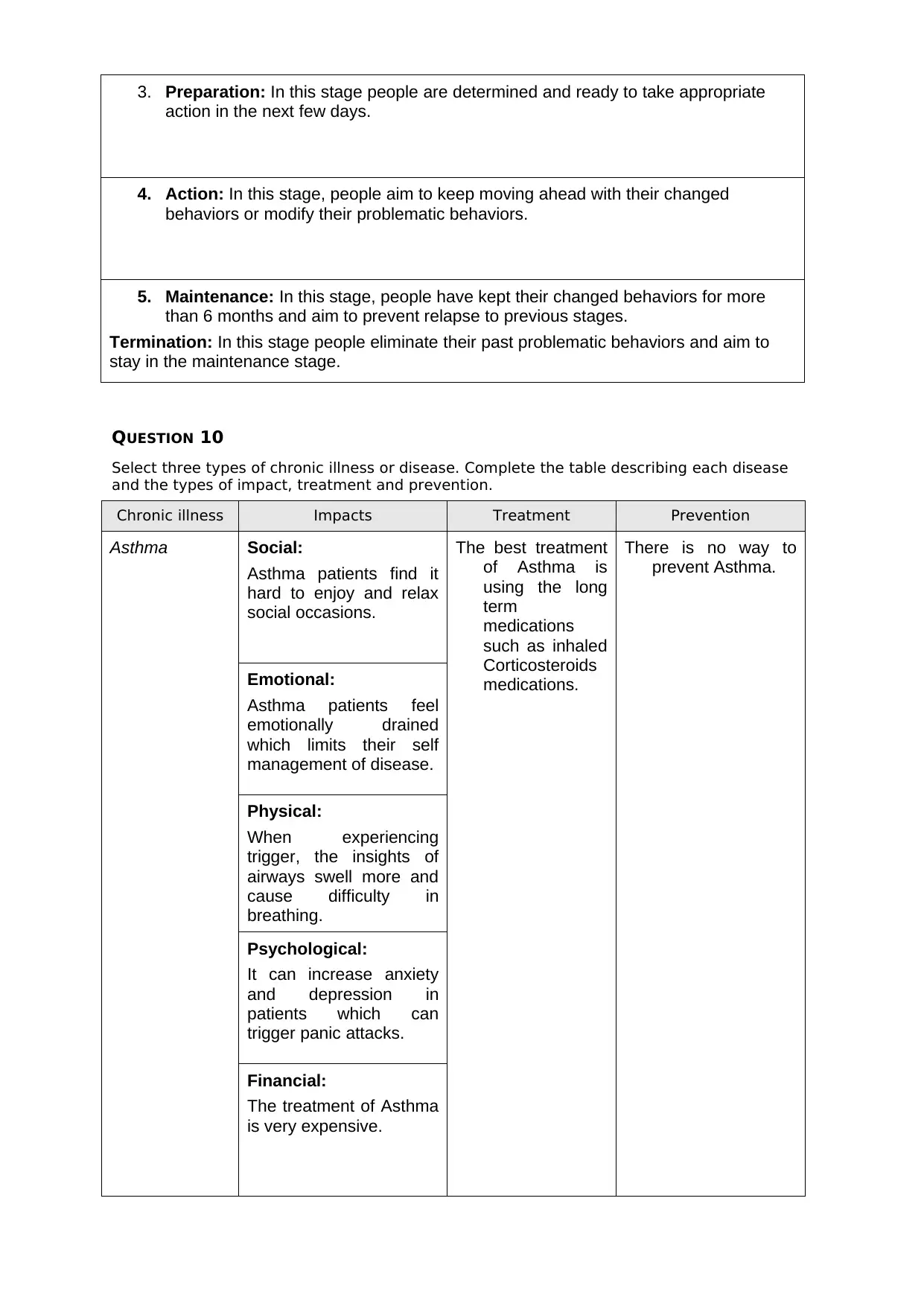
3. Preparation: In this stage people are determined and ready to take appropriate
action in the next few days.
4. Action: In this stage, people aim to keep moving ahead with their changed
behaviors or modify their problematic behaviors.
5. Maintenance: In this stage, people have kept their changed behaviors for more
than 6 months and aim to prevent relapse to previous stages.
Termination: In this stage people eliminate their past problematic behaviors and aim to
stay in the maintenance stage.
QUESTION 10
Select three types of chronic illness or disease. Complete the table describing each disease
and the types of impact, treatment and prevention.
Chronic illness Impacts Treatment Prevention
Asthma Social:
Asthma patients find it
hard to enjoy and relax
social occasions.
The best treatment
of Asthma is
using the long
term
medications
such as inhaled
Corticosteroids
medications.
There is no way to
prevent Asthma.
Emotional:
Asthma patients feel
emotionally drained
which limits their self
management of disease.
Physical:
When experiencing
trigger, the insights of
airways swell more and
cause difficulty in
breathing.
Psychological:
It can increase anxiety
and depression in
patients which can
trigger panic attacks.
Financial:
The treatment of Asthma
is very expensive.
action in the next few days.
4. Action: In this stage, people aim to keep moving ahead with their changed
behaviors or modify their problematic behaviors.
5. Maintenance: In this stage, people have kept their changed behaviors for more
than 6 months and aim to prevent relapse to previous stages.
Termination: In this stage people eliminate their past problematic behaviors and aim to
stay in the maintenance stage.
QUESTION 10
Select three types of chronic illness or disease. Complete the table describing each disease
and the types of impact, treatment and prevention.
Chronic illness Impacts Treatment Prevention
Asthma Social:
Asthma patients find it
hard to enjoy and relax
social occasions.
The best treatment
of Asthma is
using the long
term
medications
such as inhaled
Corticosteroids
medications.
There is no way to
prevent Asthma.
Emotional:
Asthma patients feel
emotionally drained
which limits their self
management of disease.
Physical:
When experiencing
trigger, the insights of
airways swell more and
cause difficulty in
breathing.
Psychological:
It can increase anxiety
and depression in
patients which can
trigger panic attacks.
Financial:
The treatment of Asthma
is very expensive.

Cancer Social:
It can strain relationships
of patients with their
friends and family.
The most common
type of
treatment for
cancer is
Surgery.
Cancer can be
prevented through
having a healthy
diet, UV
protection,
Vaccinations and
not using tobacco.
Emotional:
It can cause anxiety,
distress and depression.
Physical:
It can cause Fatigue,
hair-loss and hearing
loss etc.
Psychological:
The immediate impacts
are shock and denial.
Financial:
To the patients who do
not have insurances,
cancer results in debts
which last longer after
the ending of treatment.
Diabetes Social:
It can cause employment
complications and
decreased potentials.
The best treatment
for Diabetes is
Metformin
medication.
Diabetes can be
prevented by
regular exercise,
healthy weight
loss, quitting
smoking and a
healthy diet.
Emotional:
Patients might feel
stressed, low, depressed
and burnt out.
Physical:
Diabetes can cause
damages to large and
small blood vessels
leading to heart attacks
and strokes.
It can strain relationships
of patients with their
friends and family.
The most common
type of
treatment for
cancer is
Surgery.
Cancer can be
prevented through
having a healthy
diet, UV
protection,
Vaccinations and
not using tobacco.
Emotional:
It can cause anxiety,
distress and depression.
Physical:
It can cause Fatigue,
hair-loss and hearing
loss etc.
Psychological:
The immediate impacts
are shock and denial.
Financial:
To the patients who do
not have insurances,
cancer results in debts
which last longer after
the ending of treatment.
Diabetes Social:
It can cause employment
complications and
decreased potentials.
The best treatment
for Diabetes is
Metformin
medication.
Diabetes can be
prevented by
regular exercise,
healthy weight
loss, quitting
smoking and a
healthy diet.
Emotional:
Patients might feel
stressed, low, depressed
and burnt out.
Physical:
Diabetes can cause
damages to large and
small blood vessels
leading to heart attacks
and strokes.
⊘ This is a preview!⊘
Do you want full access?
Subscribe today to unlock all pages.

Trusted by 1+ million students worldwide
1 out of 17
Related Documents
Your All-in-One AI-Powered Toolkit for Academic Success.
+13062052269
info@desklib.com
Available 24*7 on WhatsApp / Email
![[object Object]](/_next/static/media/star-bottom.7253800d.svg)
Unlock your academic potential
Copyright © 2020–2025 A2Z Services. All Rights Reserved. Developed and managed by ZUCOL.





